Rosehill Cemetery
Rosehill Cemetery (founded 1859) is an American rural cemetery on the North Side of Chicago, Illinois, and at 350 acres (1.4 km2), is the largest cemetery in the City of Chicago. The name "Rosehill" resulted from a City Clerk's error – the area was previously called "Roe's Hill", named for nearby farmer Hiram Roe. He refused to sell his land to the city until it was promised that the cemetery be named in his honor.[2] It is located in the north east section of the Lincoln Square community area.
| Details | |
|---|---|
| Established | 1859 |
| Location | Chicago, Illinois |
| Country | United States |
| Size | 141 ha (350 acres) |
| No. of graves | over 100,000 |
| Website | Rosehill Cemetery |
Rosehill Cemetery Administration Building and Entry Gate | |
Chicago Landmark
| |
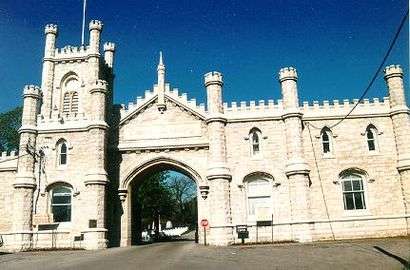 Rosehill Cemetery Gatehouse | |
   | |
| Location | 5800 N. Ravenswood Avenue, Chicago |
| Coordinates | 41°59′13″N 87°40′45″W |
| Built | 1864 |
| Architect | William W. Boyington |
| NRHP reference No. | 75000651 |
| Significant dates | |
| Added to NRHP | April 24, 1975[1] |
| Designated CL | October 16, 1980 |
Rosehill's Joliet-limestone entrance gate (added in 1864) was designed by William W. Boyington, the architect of the Chicago Water Tower and the Old University of Chicago, who is buried in Rosehill. The Rosehill Cemetery Administration Building and Entry Gate was listed on the U.S. National Register of Historic Places in 1975.[1]
Like its sister cemetery Graceland, Rosehill is the burial place of many well-known Chicagoans. The cemetery contains many monuments that are notable for their beauty and eccentricity, such as that of Lulu Fellows.[3]
The cemetery is also the final resting place of 61 victims of the Iroquois Theatre fire, in which over 600 people died.[4]
Several graves, gravestones and monuments from the old City Cemetery, originally located in what is now Lincoln Park were relocated to Rosehill Cemetery.
Landmarks
Rosehill Mausoleum
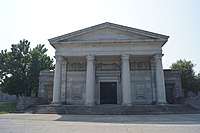
Dedicated in 1914, Rosehill Mausoleum was designed by architect Sidney Lovell. It is the largest mausoleum in Chicago and has two levels, the lower level being partially underground. The interior is constructed almost entirely of marble. The floors are Italian Carrara marble. There are many small family-owned rooms with heavy bronze gates. Some of these private rooms feature stained glass windows by Louis Comfort Tiffany among other artists. Richard B. Ogilvie, Governor of Illinois, is entombed near the ceiling in the west part of the Mausoleum. Other notables include Aaron Montgomery Ward, his business rival Richard Warren Sears, and John G. Shedd, philanthropist and president of Marshall Field & Company. The mausoleum has been expanded several times.
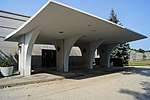
Horatio N. May Chapel
Built in 1899, the Horatio N. May Chapel was designed by architect Joseph Lyman Silsbee. It is designed in a blend of Gothic and Romanesque styles, with an exterior of granite and an interior appointed with mosaic floors and a graceful oak roof with "hammer-beam trusses and curved brackets." [5]
Civil War Memorials
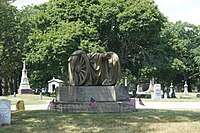
Civil War buffs have long been attracted to Rosehill, where approximately 350 Union soldiers and sailors and at least three Confederates who gave their lives in service are entombed. It is the final resting place for several members of the 8th Illinois Cavalry, the unit that fired the first shots in the Battle of Gettysburg, and of a general whose troops helped Ulysses S. Grant avoid surrender in the Battle of Shiloh, Grant's first major engagement of the war. Rosehill Cemetery maintains the distinction of being the largest private burial ground of Union veterans, including 16 generals, in the state of Illinois. To honor those who fought for country and cause, Rosehill officially opened its own Civil War Museum on January 15, 1995.
Chicago Volunteer Firefighter's Memorial
A monument "To Honor All the Courageous Volunteer Firefighters of Chicago" was erected in Rosehill Cemetery in 1864. The monument, designed by Leonard Volk, features a vigilant fireman standing atop a tall column. A fire hose is wrapped around the base. Four old-style hydrants make up the corners of the memorial. The granite marker at the base contains the names of all firefighters killed in the line of duty.
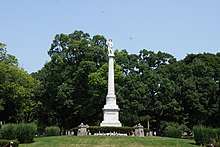
In film
Rosehill was featured in the film Next of Kin (1989). The funeral scene in Backdraft (1991) takes place at the Volunteer Firefighter's Monument at Rosehill, but was actually filmed elsewhere using a replica of this monument. Lulu Fellowes (the girl in the glass box) also appeared in the film U.S. Marshals (1998).
Fireside Restaurant & Lounge
The roadhouse now known as the Fireside Restaurant & Lounge has stood across from historic Rosehill Cemetery for more than a century. It is one of the oldest continuously operating taverns in Chicago. The original tavern once served traveling farmers and mourners alike, even offering accommodations.
West Ridge Nature Preserve
In 2015, the Chicago Park District Park No. 568 - West Ridge Nature Preserve was established along the north western edge of Rosehill Cemetery. The park land, which was once part of the cemetery, features 20.585 acres of restored woodland, native plants, boardwalks, a 4.5 acre pond, a multipurpose trail around the park with elevated overlooks, educational and interpretive signage for easy identification of plantings, fishing stations and wildlife viewing opportunities.[6]
Notable burials
- James Aldrich, U.S. Congressman, Illinois 1st Congressional District (1893–1897)
- William Aldrich, U.S. Congressman, Illinois 1st Congressional District (1877–1883)
- George Bangs, Railway Mail Service
- George Bell, Jr., United States Army Major General who commanded the 33rd Infantry Division in World War I
- John Lourie Beveridge, Illinois Governor (1873–1877)
- Lester L. Bond, Chicago Mayor (August–December 1873)
- Levi Boone, Chicago Mayor (1855–1856), anti-immigrant American Party (a.k.a. The Know-Nothing Party)
- William W. Boyington, architect, Chicago Water Tower and Rosehill Cemetery entrance
- Jack Brickhouse, Hall of Fame sports broadcaster
- Austin Brooks, Editor, Quincy Herald (1853-1867)
- Avery Brundage, athlete, construction contractor, president of the United States Olympic Committee (USOC) and International Olympic Committee (IOC)
- Henry Buker, baseball shortstop. right fielder 1884 Detroit Wolverines
- Jacob Burck, Pulitzer prize-winning editorial cartoonist and artist for St. Louis Post-Dispatch and the Chicago Sun-Times
- Leo Burnett, advertising executive, founder of Leo Burnett Worldwide
- Edward Dean Cooke, U.S. Congressman, Illinois 6th Congressional District (1895–1897)
- Joseph Cummings, president of Wesleyan University (1857–1875), president of Northwestern University (1881–1890)
- Albert Blake Dick, founder of A.B. Dick Company, coined the word "mimeograph"
- Jim Dooley, Chicago Bears football player, coach
- Harvey Doolittle Colvin, Chicago Mayor (1873–1875)
- Dewitt Clinton Cregier, Chicago Mayor (1889–1891)
- George R. Davis, U.S. Congressman, Illinois (1879–1885), Director General, World's Columbian Exposition
- Charles G. Dawes, 30th Vice President of the United States
- Martin Emerich, Maryland House of Delegates, U.S. Congressman, Illinois 1st Congressional District (1903–1905)
- Charles Benjamin Farwell, U.S. Congressman, U.S. Senator from Illinois
- Milton S. Florsheim, founder of Florsheim Shoe Company
- Mimi Forsythe, actress Three Russian Girls, The Bridge Of San Luis Rey
- Bobby Franks, murder victim of Leopold and Loeb
- Lyman J. Gage, U.S. Secretary of the Treasury (1897–1902), banker, president of the World's Columbian Exposition
- Augustus Garrett, Chicago Mayor (1843–1844, 1845–1846)
- Samuel Robert Gibson, folk singer Gibson and Camp at the Gate of Horn
- Solomon Harry Goldberg, founder Hump Hairpin Manufacturing Company, patented hairpin made with ridges
- Harry Grabiner, Major League Baseball executive, first general manager of Chicago White Sox
- Elisha Gray, inventor, founder Western Electric
- Dwight H. Green, Governor of Illinois (1941–1949)
- Charles Frederick Gunther confectionery manufacturing magnate, created Cracker Jack
- John Charles Haines, Chicago Mayor (1858–1860)
- Winifred M. Hausam, one of the most creative educators in Southern California and credited with organizing many vocational and counseling bureaus
- John D. Hertz, founder Yellow Cab, Hertz Rent-A-Car; Re-interred at Woodlawn Cemetery, The Bronx, New York
- Otis Hinckley, co-founder Hinckley & Schmitt
- Ida Sophia Hippach, R.M.S. Titanic survivor
- Jerome Holtzman, Baseball Hall of Fame sportswriter, known as "The Dean" of baseball press boxes
- Nat Hudson, Major League Baseball pitcher (1886–1889) for the St. Louis Browns.
- Charles J. Hull, real estate magnate, Hull House owner
- Edgar Allan Jonas, U.S. Congressman Illinois 12th Congressional District (1949–1955)
- Edward Jump, artist, cartoonist
- Andrew Thomas Kearney, founder of management consulting firm A.T. Kearney
- John H. Kedzie, lawyer, real-estate developer, politician (namesake: Kedzie Avenue in Chicago and Kedzie Street, Evanston)
- Harry Stephen Keeler, pulp mystery writer, The Case Of The Barking Clock, The Man With The Magic Eardrums
- James Scott Kemper, founder of Lumberman's Mutual Casualty Company, predecessor of Kemper Corporation
- Edward N. Kirk, Union Army brigadier general, U.S. Civil War
- Philip Knopf, U.S. Congressman Illinois 7th Congressional District (1903–1909)
- Leonidas Lee, Major League Baseball player, 1877
- Benjamin F. Lindheimer, Chicago horse racing and football executive
- John Mason Loomis, lumber baron, philanthropist, and Civil War colonel.
- Sidney Lovell, architect of Rosehill Mausoleum
- Alexander Loyd, Chicago Mayor (1840–1841)
- Benjamin Drake Magruder, Illinois Supreme Court Justice
- George W. Maher, architect, Prairie School-style
- Robert Marsh, victim in the Herrin Massacre (unmarked grave)
- Roswell B. Mason, Chicago Mayor (1869–1871), mayor during Great Chicago Fire
- Victor Andre Matteson, architect Cardinal Hill Reservoir
- Oscar F. Mayer, business magnate, founder Oscar Mayer Company
- John McArthur Union general, U.S. Civil War
- Edward McWade, actor Arsenic and Old Lace, Yankee Doodle Dandy, Mr. and Mrs. North; spouse of Margaret
- Margaret McWade, actress Mr. Deeds Goes to Town; wife of Edward
- Robert McWade, theater, film actor Grand Hotel, The Lemon Drop Kid; brother of Edward
- Darius Miller,[7][8] railroad president
- Isaac Lawrence Milliken, Chicago Mayor (1854–1855)
- Buckner Stith Morris, Chicago Mayor (1838–1839)
- Richard B. Ogilvie, Governor of Illinois (1969–1973)
- Martha O'Driscoll, actress: Li’l Abner, Ghost Catchers, House of Dracula, The Daltons Ride Again, Under Western Skies
- George Arthur Paddock, U.S. Congressman Illinois 10th District (1941–1943)
- Legrand Winfield Perce, U.S. Congressman (1870–1873)
- Eliza Emily Chappell Porter, first school teacher in Chicago (1835), established schools for African American children in the south
- Thomas E. G. Ransom, brevet major general in the US Civil War, division commander in the Thirteenth, Sixteenth and Seventeenth Corps, died 1864[9]
- Henry Riggs Rathbone, U.S. Congressman, Illinois Congressman At-Large (1923–1928)
- Ira G. Rawn,[10] railroad president
- John Blake Rice, Chicago Mayor (1865–1869)
- Bruce Roberts, television pioneer, longtime WBBM-TV weekend sportscaster
- John A. Roche, Chicago Mayor (1887–1889)
- Julius Rosenwald, merchant, early partner with Richard Sears, founder the Museum of Science and Industry in Jackson Park.
- Morris Sachs, entrepreneur, Morris B. Sachs Amateur Hour radio program
- George Joseph Schmitt, co-founder of Hinckley & Schmitt bottled water
- Reinhart Schwimmer, gangster, St. Valentine's Day Massacre victim
- Ignaz Schwinn, founder of the Schwinn Bicycle Company
- Richard Warren Sears, founder of Sears, Roebuck and Company
- John G. Shedd, Chairman of Marshall Field & Company, philanthropist, founder of the Shedd Aquarium
- Milton Sills, actor "The Heart Bandit", "The Hawk's Nest", "The Sea Wolf"
- Edwin Silverman, co-founder of Essaness Theatres[11]
- Roslyn Simon, Wife of Justice Seymour Simon, Chicago Philanthropist and Miss Philadelphia (1932)
- Honorable Justice Seymour Simon, Illinois Supreme Court (1980-1988), Illinois Appellate Court (1974-1980), President, Cook County Board, (1962-1966), 40th Ward Alderman (1955-1962,1966-1974)
- Byron Laflin Smith, founder Northern Trust Company
- William Grant Stratton, Illinois Governor (1953–1961)
- Benjamin Sweet, lawyer, politician, administrator, colonel in the Union Army, two of whose daughters pioneered women's rights (1832-1874).
- Charles Wheeler Sweet, Sr., professional tennis player (1905-1971)
- George Bell Swift, Chicago Mayor (1893, 1895–97)
- Charles Marsh Thomson, U.S. Congressman Illinois 10th District (1913–1915)
- Narcissa Niblack Thorne, designer of the Thorne miniature rooms, Art Institute of Chicago
- Burr Tillstrom, puppeteer, creator of Kukla, Fran and Ollie
- Belle Kellogg Towne, hymn composer, author and editor for the David C. Cook Publishing Company, buried with husband, T. Martin Towne, well-known composer
- Daniel Brink Towner, hymn composer Trust and Obey, Grace Greater than our Sin, Saved by the Blood of the Crucified One
- Robert Twyman, U.S. Congressman Illinois 9th District (1947–1949)
- Leonard W. Volk, sculptor, notable for making one of only two life masks of U.S. President Abraham Lincoln
- E. S. Wadsworth, co-founder Wadsworth, Dyer & Chapin, namesake Wadsworth, Illinois
- Martin R. M. Wallace, Union brevet brigadier general, U.S. Civil War
- Aaron Montgomery Ward, founder Montgomery Ward and Company, the world's first mail order business
- John Wentworth (nicknamed "Long John"), U.S. Congressman, mayor of Chicago, marked by the tallest obelisk in the cemetery
- George Elon White, U.S. Congressman Illinois's 5th District (1895–1899)
- Julius White brigadier general Union Army, U.S. Civil War
- Frances Willard, temperance leader, suffragist, President of the Women's Christian Temperance Union
- Ned Williamson, Major League Baseball player, 1878–1890
- Prince Arnold zu Windisch-Graetz, pastor Concordia Lutheran Church of Chicago and member of the House of Windisch-Graetz
- Henry Haven Windsor, founder, publisher of Popular Mechanics magazine
- Charles Walhart Woodman, U.S. Congressman Illinois 4th District (1895–1897)
- Warren Wright Sr., Calumet Baking Powder Company, Calumet Farm (1875-1950)
References
- "National Register Information System". National Register of Historic Places. National Park Service. April 15, 2008.
- "Revisiting Roe's Hill and Our Shoreline". edgewaterhistory.org.
- Matt Hucke (2010). "Rosehill Cemetery and Mausoleum: Lulu Fellows". Graveyards.com. Retrieved 2015-08-25.
- Find A Grave. "Victims of the Iroquois Theatre Fire". Retrieved 14 March 2020.
- "Costly Tombs of the Rich". Chicago Tribune. August 19, 1900. p. 51.
- "West Ridge Nature Play Space". Chicago Park District.
- "Rosehill Cemetery and Mausoleum: Darius Miller". Graveyards.com. Retrieved November 30, 2013.
- "The Curse of King Tut". Gravely Speaking. January 9, 2013. Retrieved November 30, 2013.
- Karamanski, Theodore J.; McMahon, Eileen M., eds. (2014). Civil War Chicago. Ohio University Press. p. 270. ISBN 978-0821444818.
- "Ira G. Rawn, 20 Jul 1910". FamilySearch. "Illinois, Cook County Deaths, 1878–1922", index. Retrieved November 22, 2013.
- "Edwin Silverman Services Set Saturday in Chicago". Desert Sun. 43 (163). Palm Springs, California. 12 February 1970. p. 3.
External links
| Wikimedia Commons has media related to Rosehill Cemetery. |
- Official website
- Rosehill Cemetery Civil War Museum
- Photographs of Rosehill Cemetery
- Rosehill Cemetery on Graveyards.com
- Rosehill Cemetery and Mausoleum at Find a Grave
- U.S. Geological Survey Geographic Names Information System: Rosehill Cemetery
- U.S. Geological Survey Geographic Names Information System: Rosehill Mausoleum
- Haunted USA
- Clown Trespasses At Chicago Cemetery In Dead Of Night
- Chicago Park District Park No. 568
- Sears Founder Still Hangs Around